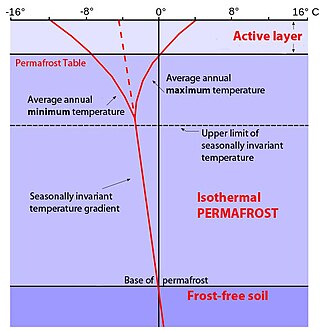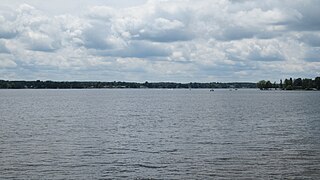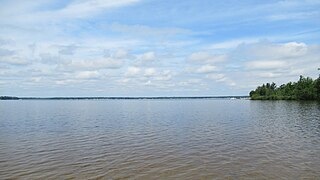
Cadillac is a city in and county seat of Wexford County in the U.S. state of Michigan. The population was 10,371 at the 2020 census, which ranks it the second most-populated city in the Northern Michigan region, after Traverse City.

Lake-effect snow is produced during cooler atmospheric conditions when a cold air mass moves across long expanses of warmer lake water. The lower layer of air, heated by the lake water, picks up water vapor from the lake and rises through colder air. The vapor then freezes and is deposited on the leeward (downwind) shores.

Wexford County is a county in the Northern Lower Peninsula of the U.S. state of Michigan. As of the 2020 United States Census, the population was 33,673. The seat of Wexford County is Cadillac, which is also the county's largest city.

Clam Lake Township is a civil township of Wexford County in the U.S. state of Michigan. The population was 2,467 at the 2010 census.

Haring Township is a charter township of Wexford County in the U.S. state of Michigan. The population was 3,173 at the 2010 census.

Ice wine is a type of dessert wine produced from grapes that have been frozen while still on the vine. The sugars and other dissolved solids do not freeze, but the water does, allowing for a more concentrated grape juice to develop. The grapes' must is then pressed from the frozen grapes, resulting in a smaller amount of more concentrated, very sweet juice. With ice wines, the freezing happens before the fermentation, not afterwards. Unlike the grapes from which other dessert wines are made, such as Sauternes, Tokaji, or Trockenbeerenauslese, ice wine grapes should not be affected by Botrytis cinerea or noble rot, at least not to any great degree. Only healthy grapes keep in good shape until the opportunity arises for an ice wine harvest, which in extreme cases can occur after the New Year, on a northern hemisphere calendar. This gives ice wine its characteristic refreshing sweetness balanced by high acidity. When the grapes are free of Botrytis, they are said to come in "clean". This results in a very complex and sweet wine. Much ice wine is made from the grapes Riesling, Vidal, Cabernet Franc and Cabernet Sauvignon, but there is also ice wine made from Shiraz, Merlot, Sangiovese and others.

Mud season or breakup is a period in late winter and early spring when travel over ice is no longer safe and travel overland is more difficult as frozen earth thaws and soil becomes muddy from melting snow.

The Snowbelt is the region near the Great Lakes in North America where heavy snowfall in the form of lake-effect snow is particularly common. Snowbelts are typically found downwind of the lakes, principally off the eastern and southern shores.

Haring is an unincorporated community and census-designated place (CDP) in Wexford County in the U.S. state of Michigan. The population of the CDP was 335 as of the 2020 census. Haring is located within Haring Charter Township just north of the city of Cadillac.

An ice volcano is a conical mound of ice formed over a terrestrial lake via the eruption of water and slush through an ice shelf. The process is wave-driven, with wind providing the energy for the waves to cut through the ice and create formations that loosely mimic the shape and activity of volcanoes. After being ejected into the atmosphere, the liquid water and slush freeze and fall back to the surface, growing the formation. Ice may also be erupted. The phenomenon is most often observed along the southern coast of Lake Erie and Lake Ontario, when the temperature is below freezing and the wind blows onshore with a velocity of at least 25 mph (40 km/h). They are known to reduce coastal erosion there. The formations are temporary: they are frequently destroyed by storms and warm weather, and once the lake wholly freezes over, eruptions are no longer possible.

In environments containing permafrost, the active layer is the top layer of soil that thaws during the summer and freezes again during the autumn. In all climates, whether they contain permafrost or not, the temperature in the lower levels of the soil will remain more stable than that at the surface, where the influence of the ambient temperature is greatest. This means that, over many years, the influence of cooling in winter and heating in summer will decrease as depth increases.

An ice spike is an ice formation, often in the shape of an inverted icicle, that projects upwards from the surface of a body of frozen water. Ice spikes created by natural processes on the surface of small bodies of frozen water have been reported for many decades, although their occurrence is quite rare. A mechanism for their formation, now known as the Bally–Dorsey model, was proposed in the early 20th century but this was not tested in the laboratory for many years. In recent years a number of photographs of natural ice spikes have appeared on the Internet as well as methods of producing them artificially by freezing distilled water in domestic refrigerators or freezers. This has allowed a small number of scientists to test the hypothesis in a laboratory setting and, although the experiments appear to confirm the validity of the Bally–Dorsey model, they have raised further questions about how natural ice spikes form, and more work remains to be done before the phenomenon is fully understood. Natural ice spikes can grow into shapes other than a classic spike shape, and have been variously reported as ice candles, ice towers or ice vases as there is no standard nomenclature for these other forms. One particularly unusual form takes the shape of an inverted pyramid.

William Mitchell State Park is a public recreation area covering 334 acres (135 ha) within the city limits of Cadillac in northern lower Michigan. The state park is located between Lake Mitchell and Lake Cadillac. The historic Clam Lake Canal, approximately one-third of a mile in length, connects the two lakes and runs directly through the park. Dug in 1873 at the direction of city father George A. Mitchell, the canal allowed felled trees to be floated from Lake Mitchell to lumber mills on Lake Cadillac.
"The Resurrection of Jimber-Jaw" is a 1937 short story by American writer Edgar Rice Burroughs, about an unfrozen 50,000-year-old caveman.

Lake Cadillac is a lake located within the city of Cadillac, Michigan. It is part of the Muskegon River watershed.

Cryopreservation or cryoconservation is a process where biological material - cells, tissues, or organs - are frozen to preserve the material for an extended period of time. At low temperatures any cell metabolism which might cause damage to the biological material in question is effectively stopped. Cryopreservation is an effective way to transport biological samples over long distances, store samples for prolonged periods of time, and create a bank of samples for users. Molecules, referred to as cryoprotective agents (CPAs), are added to reduce the osmotic shock and physical stresses cells undergo in the freezing process. Some cryoprotective agents used in research are inspired by plants and animals in nature that have unique cold tolerance to survive harsh winters, including: trees, wood frogs, and tardigrades.

Lake Mitchell is one of two lakes in Wexford County, Michigan, that are joined together by the Clam Lake Canal. The other lake is Lake Cadillac.

The Masonic Temple in Cadillac, Michigan is a commercial building built in 1899. It is the earliest surviving fraternal building designed by the prolific architect Sidney Osgood. It was listed on the National Register of Historic Places in 1994.

The Cobbs and Mitchell Building is an office building located at 100 East Chapin Street in Cadillac, Michigan. It was designated a Michigan State Historic Site in 1980. and listed on the National Register of Historic Places in 2010.

George A. Mitchell was an American businessman, merchant, railwayman, lumber baron, and real estate developer. In the 1870s he bought 2,000 acres (810 ha) of land in Michigan, divided and sold it in lots, and established the village of Clam Lake. The village's name later changed to Cadillac, with Mitchell as its founder becoming its first mayor.
























